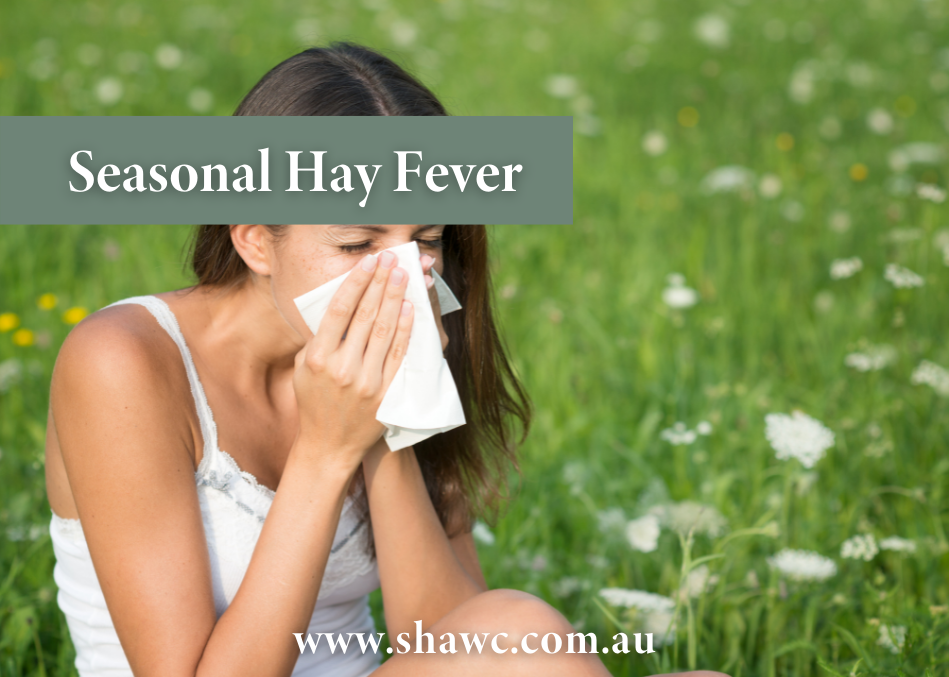A runny nose, watery eyes and difficulty breathing. Sound familiar?
For many, these symptoms are commonplace.
Hay fever (also known as allergic rhinitis) describes an inflammatory nose condition triggered by an allergic reaction. According to the Australian Institute of Health and Welfare (AIHW), almost one in five Australians have allergic rhinitis. Symptoms are often seasonal, especially during Spring when airborne pollen and spores begin to peak.
While pollen is an extremely common allergen,
other agents can trigger an allergic response and contribute to hay fever as well. Dust, airborne contaminants, mould, dust mites, pet dander, cockroaches, environmental chemicals, cleaning products, personal care products, and foods can all cause allergic reactions.
If you have never had an allergy, it is still possible to develop one in the future!
Allergies are your body’s reaction to particles that it considers foreign. As part of your body’s defence system, the next time it encounters a particular allergen, within a few minutes your mast cells become activated and release a powerful cocktail of histamine, leukotrienes, and prostaglandins. These then trigger sneezing, runny nose, itchy eyes, sore throat, cough, and in some people an asthma attack.
Who is at risk of developing hay fever?
- A family history of atopic conditions (eczema, asthma, hay fever).
- Frequent upper airway infections and sinusitis.
- Frequent antibiotic use may cause alteration to your intestinal microbiome.
- Altered microbiome balance, due to poor digestive function.
- A diet high in sugar and processed foods and low in essential nutrients.
- Food sensitivities: common allergens include eggs, nuts, fish, shellfish, dairy or wheat.
- Structural abnormalities such as a deviated septum.
- Early exposure to allergens/pollution such as smoke and chemicals.
- Environmental allergens – dust mites, feathers, animal dander, mould, pollen, and grass.
My top basic tips for managing hay fever and allergies include the following:
- Use a Neti pot or sinus cleanse to flush your nasal cavity of pollens and other irritants. Literally detaches the irritant from the mucous membranes in your sinus.
- Avoid being outside at high pollen times. Shut the windows during spring and especially in the afternoon and evenings. Avoid parks and gardens during the late afternoon, especially when it’s windy.
- Avoid drying washing outside if pollen counts are high as it can get trapped in the fibres of clothes and bed linen.
- Recognise, identify, and manage your exposure to any indoor allergens (such as dust etc)
- Engaging in regular exercise to support the lymphatic system.
- Quercetin and bromelain: both powerful nutrients that may assist hay fever symptoms by reducing sinus inflammation and histamine release. They can be consumed in foods and/or in supplemental form; Quercetin can be found in broccoli, red onion, capsicum, berries, grapes and green tea, while bromelain is rich in pineapple.
- Eating for gut health. Research shows strong associations between imbalances of gut bacteria/gut dysfunction with atopic conditions such as hay fever, allergies and eczema. Fibre, prebiotics and special strains of probiotics have been shown to alleviate and prevent symptoms of allergic rhinitis/hay fever.
- Reduce alcohol, processed sugar, dairy and wheat consumption and include plenty of whole foods, citrus and dark leafy greens.
- Specific nutrients and herbal medicine can be extremely helpful in balancing the immune system, and reducing histamine release as well as inflammation.
There’s no reason to suffer from your seasonal allergies anymore; book an appointment with us to settle them once and for all.
Get in touch today to make an appointment with our experienced naturopath Cassandra at Sustainable Health and Wellness Clinic.




